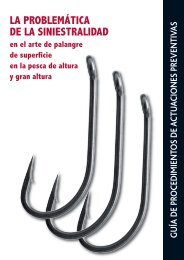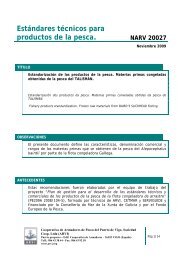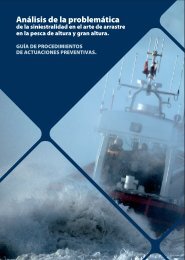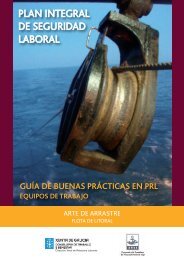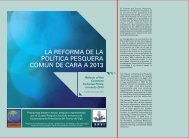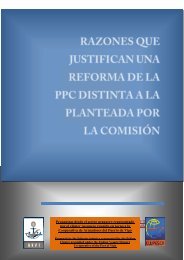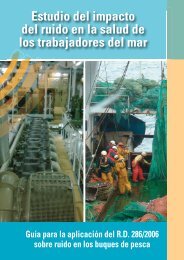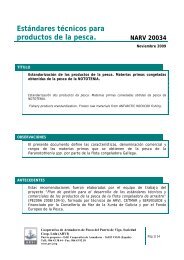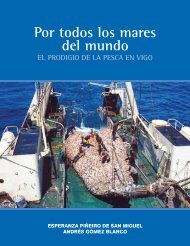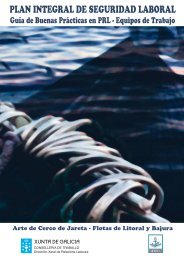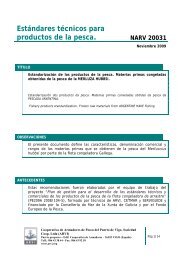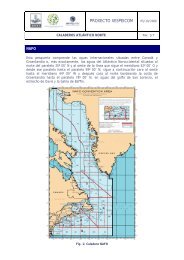¿porqué la internacionalización de las empresas pesqueras ... - Arvi
¿porqué la internacionalización de las empresas pesqueras ... - Arvi
¿porqué la internacionalización de las empresas pesqueras ... - Arvi
Create successful ePaper yourself
Turn your PDF publications into a flip-book with our unique Google optimized e-Paper software.
~ 1 ~<br />
WHY IS THE<br />
INTERNATIONALIZATION OF<br />
FISHING COMPANIES NOT<br />
INCLUDED IN THE REFORM OF<br />
THE CFP?<br />
Propuestas <strong>de</strong>s<strong>de</strong> el sector pesquero representado<br />
por el clúster pesquero reunido en torno a <strong>la</strong><br />
Cooperativa <strong>de</strong> Armadores <strong>de</strong>l Puerto <strong>de</strong> Vigo<br />
Proposals by the fisheries industry represented by the fishing<br />
Cluster assembled un<strong>de</strong>r the Fishing Vessels’Owners<br />
Co-operative of the Port of Vigo<br />
1
¿POR QUÉ LA INTERNACIONALIZACIÓN DE LAS<br />
EMPRESAS PESQUERAS NO SE INCLUYE<br />
EN LA REFORMA DE LA PPC<br />
WHY IS THE INTERNATIONALIZATION OF FISHING COMPANIES<br />
NOT INCLUDED IN THE REFORM OF THE CFP?<br />
OCTUBRE/OCTOBER 2012<br />
Cooperativa De Armadores De Pesca Del Puerto De Vigo, S. Coop. Ltda.<br />
Cluster <strong>de</strong>l Sector Pesquero Extractivo y Productor<br />
Puerto Pesquero, Edificio Ramiro Gor<strong>de</strong>jue<strong>la</strong>. Apdo. 1078. 36202 Vigo (España)<br />
Telef.: +34 986433844 / Fax: +34 986439218 / E mail: arvi@arvi.org Web: www.arvi.org<br />
2
Cooperativa <strong>de</strong> Armadores <strong>de</strong> Pesca<br />
<strong>de</strong>l Puerto <strong>de</strong> Vigo, S. Coop. Gallega<br />
Cluster <strong>de</strong>l Sector Pesquero<br />
Extractivo y Productor<br />
¿POR QUÉ LA INTERNACIONALIZACIÓN DE LAS<br />
EMPRESAS PESQUERAS NO SE INCLUYE<br />
EN LA REFORMA DE LA PPC<br />
INDICE<br />
Página<br />
1. INTRODUCCIÓN ........................................................................................................... 4<br />
2. LOS DATOS ................................................................................................................... 4<br />
2.1. LAS INVERSIONES EN TERCEROS PAÍSES ........................................................... 5<br />
2.2. LAS EXPORTACIONES ........................................................................................... 6<br />
3. ¿CUAL ES LA OPINION DE LA UE SOBRE LA INTERNACIONALIZACIÓN DE SUS<br />
EMPRESAS? .......................................................................................................................... 9<br />
4. ENTONCES ¿POR QUÉ LA REFORMA DE LA PPC NO HABLA DE ESTE OBJETIVO?<br />
9<br />
5. CONCLUSIONES ............................................................................................................ 9<br />
6. PROPUESTAS DE ACTUACIÓN ................................................................................. 10<br />
3
Cooperativa <strong>de</strong> Armadores <strong>de</strong> Pesca<br />
<strong>de</strong>l Puerto <strong>de</strong> Vigo, S. Coop. Gallega<br />
Cluster <strong>de</strong>l Sector Pesquero<br />
Extractivo y Productor<br />
¿POR QUÉ LA INTERNACIONALIZACIÓN DE LAS<br />
EMPRESAS PESQUERAS NO SE INCLUYE<br />
EN LA REFORMA DE LA PPC<br />
1. INTRODUCCIÓN<br />
La <strong>internacionalización</strong> <strong>de</strong> <strong>la</strong>s <strong>empresas</strong> europeas es un factor c<strong>la</strong>ve para <strong>la</strong><br />
competitividad <strong>de</strong> <strong>la</strong>s mismas ante un mundo cada vez más globalizado e<br />
interconectado. Europa es una <strong>de</strong> <strong>la</strong>s economías más abiertas <strong>de</strong>l mundo, pero <strong>la</strong><br />
competencia por parte <strong>de</strong> economías <strong>de</strong>sarrol<strong>la</strong>das y emergentes es cada vez mayor.<br />
En el sector pesquero, nuestras <strong>empresas</strong> llevan muchos años compitiendo sin apenas<br />
barreras arance<strong>la</strong>rias 1 y una parte <strong>de</strong> el<strong>la</strong>s también lleva mucho tiempo inmersa en un<br />
proceso continuo <strong>de</strong> <strong>internacionalización</strong> a través <strong>de</strong> <strong>la</strong>s exportaciones <strong>de</strong> pescado y/o<br />
<strong>de</strong> <strong>la</strong>s inversiones <strong>pesqueras</strong> que llevan a cabo en países terceros 2 .<br />
La Estrategia 2020 <strong>de</strong> <strong>la</strong> Unión Europea para el crecimiento nos <strong>de</strong>ja c<strong>la</strong>ro que se <strong>de</strong>be<br />
promover un crecimiento sostenible a través <strong>de</strong>l comercio mundial, mediante <strong>la</strong>s<br />
exportaciones y <strong>la</strong>s importaciones; así como <strong>la</strong>s inversiones en países terceros. Por ello;<br />
uno <strong>de</strong> los objetivos c<strong>la</strong>ve para po<strong>de</strong>r seguir siendo competitivos es el <strong>de</strong> promover <strong>la</strong><br />
<strong>internacionalización</strong> <strong>de</strong> <strong>la</strong>s <strong>empresas</strong> comunitarias.<br />
El objetivo <strong>de</strong> este Informe es poner <strong>de</strong> manifiesto el que, a pesar <strong>de</strong> <strong>la</strong> tradicional<br />
apuesta <strong>de</strong> <strong>la</strong>s <strong>empresas</strong> <strong>pesqueras</strong> europeas en exportar sus productos y salir al<br />
exterior, este punto fuerte no se recoge en <strong>la</strong> reforma <strong>de</strong> <strong>la</strong> PPC. Preten<strong>de</strong>mos con ello<br />
sensibilizar a los políticos, gestores y a <strong>la</strong> opinión pública en general, <strong>de</strong> <strong>la</strong> necesidad <strong>de</strong><br />
que una Política común como es <strong>la</strong> Pesquera APOYE EXPRESAMENTE LA<br />
INTERNACIONALIZACÓN DE LAS EMPRESAS PESQUERAS COMO FACTOR NECESARIO<br />
PARA UN CRECIMIENTO SOSTENIBLE DE LA ECONOMIA EN LAS REGIONES ALTAMENTE<br />
DEPENDIENTES DE LA PESCA.<br />
2. LOS DATOS<br />
Los dos elementos esenciales <strong>de</strong> <strong>la</strong> <strong>internacionalización</strong> son <strong>la</strong>s inversiones en terceros<br />
países y <strong>la</strong>s exportaciones:<br />
1 El pescado como materia prima es uno <strong>de</strong> los productos cuya tarifa aduanera común es <strong>de</strong> <strong>la</strong>s más bajas<br />
2 Tanto en buques <strong>de</strong> pesca como en p<strong>la</strong>ntas frigoríficas y <strong>de</strong> transformación <strong>de</strong> pescado, etc.<br />
4
ARVI / CLUPESCA<br />
2.1. LAS INVERSIONES EN TERCEROS PAÍSES<br />
Las <strong>empresas</strong> <strong>pesqueras</strong> comunitarias tienen una <strong>la</strong>rga tradición en inversiones en<br />
países terceros, tanto en <strong>la</strong> adquisición <strong>de</strong> buques como en <strong>la</strong> insta<strong>la</strong>ción <strong>de</strong> p<strong>la</strong>ntas,<br />
frigoríficos, p<strong>la</strong>ntas <strong>de</strong> e<strong>la</strong>boración, etc, en tierra.<br />
El ejemplo más representativo es el <strong>de</strong> <strong>la</strong>s <strong>empresas</strong> asociadas en torno al Clúster <strong>de</strong><br />
Empresas Pesqueras en Países Tercero (CEPPT).<br />
En este Clúster están asociadas 118 <strong>empresas</strong> con 321 barcos que operan en 24<br />
países <strong>de</strong> todo el mundo 3 . Estas inversiones permiten una producción, tanto a<br />
bordo como en tierra, en torno a 420.000 tone<strong>la</strong>das <strong>de</strong> pescado anuales que,<br />
mayoritariamente, se <strong>de</strong>stinan al mercado comunitario.<br />
En cuanto al empleo a bordo <strong>de</strong> los barcos, hay unos 1.500 tripu<strong>la</strong>ntes comunitarios<br />
y unos 6.500 no comunitarios. En tierra (p<strong>la</strong>ntas <strong>de</strong> e<strong>la</strong>boración) se da empleo a<br />
varios miles <strong>de</strong> trabajadores, lo que permite fijar pob<strong>la</strong>ción en estos territorios<br />
Is<strong>la</strong>s Seychelles<br />
Kiribati<br />
3 Ver “cluster<strong>de</strong>pesca.es” y “transparentsea.co”<br />
5
ARVI / CLUPESCA<br />
2.2. LAS EXPORTACIONES<br />
Si bien es cierto que <strong>la</strong> UE es <strong>de</strong>ficitaria en productos <strong>de</strong> <strong>la</strong> pesca y <strong>la</strong> acuicultura<br />
siendo, junto a Japón y a EE.UU., uno <strong>de</strong> los tres principales importadores <strong>de</strong>l<br />
mundo, también es cierto que <strong>la</strong>s exportaciones, tanto intra como<br />
extracomunitarias, también van creciendo cada año, lo que supone un factor <strong>de</strong><br />
<strong>internacionalización</strong> creciente <strong>de</strong> <strong>la</strong>s <strong>empresas</strong> <strong>pesqueras</strong> comunitarias:<br />
PAÍS<br />
(*)<br />
EXPORTACIONES<br />
2010<br />
TONELADAS<br />
EUROS<br />
SE 571.295<br />
DK 892.303<br />
UK 493.416<br />
1.745.739<br />
2.685.474<br />
1.456.139<br />
NL 878.373 2.476.255<br />
DE 761.991 1.717.599<br />
FR 296.654 1.123.134<br />
ES 1.013.673 2.450.963<br />
(*)SE=Suecia; DK=Dinamarca; UK= Reino Unido; NL= Ho<strong>la</strong>nda; DE= Alemania; FR= Francia; ES= España<br />
Fuente: La Política Pesquera Común en cifras (2012). Comisión Europea<br />
Vemos como Dinamarca, Ho<strong>la</strong>nda y España se sitúan a <strong>la</strong> cabeza <strong>de</strong> los países<br />
exportadores con el 43% <strong>de</strong>l total. Después, y a más distancia, le siguen Suecia,<br />
Alemania, Reino Unido y Francia.<br />
6
ARVI / CLUPESCA<br />
Por productos, <strong>la</strong>s exportaciones se distribuyen <strong>de</strong> <strong>la</strong> siguiente forma (valor en miles<br />
<strong>de</strong> euros. Total <strong>de</strong> intercambios intra y extracomunitarios):<br />
Productos frescos y refrigerados<br />
Productos conge<strong>la</strong>dos<br />
SE<br />
DK<br />
UK<br />
NL<br />
FR<br />
ES<br />
DE<br />
OTROS<br />
775.349<br />
681.820<br />
565.214<br />
460.635<br />
314.890<br />
1.511.102<br />
1.188.312<br />
1.187.768<br />
ES<br />
NL<br />
DE<br />
DK<br />
UK<br />
FR<br />
OTROS<br />
735.015<br />
720.400<br />
557.995<br />
337.645<br />
1.120.392<br />
1.347.700<br />
1.543.989<br />
Total EU-27 6 685 090 Total EU-27 6 363 136<br />
Productos ahumados, en sa<strong>la</strong>zón, secos<br />
Preparados y conservas<br />
DK<br />
SE<br />
DE<br />
NL<br />
ES<br />
UK<br />
FR<br />
OTROS<br />
282.309<br />
252.932<br />
171.133<br />
141.996<br />
95.321<br />
92.813<br />
69.823<br />
594.145<br />
ES<br />
DK<br />
NL<br />
DE<br />
FR<br />
OTROS<br />
167.266<br />
506.755<br />
418.209<br />
403.197<br />
363.024<br />
1.170.934<br />
Total EU-27 1 700 472 Total EU-27 3 029 385<br />
Fuente: La Política Pesquera Común en cifras (2012). Comisión Europea<br />
Vemos como los productos frescos, seguidos <strong>de</strong> los conge<strong>la</strong>dos y los preparados y<br />
conservas, son los principales productos que se exportan, tanto <strong>de</strong>ntro como fuera<br />
<strong>de</strong> <strong>la</strong> UE.<br />
7
ARVI / CLUPESCA<br />
En cuanto a nuestros principales clientes, EE.UU (11%), Suiza (9%), Rusia (8%),<br />
Noruega (8%), China (8%) y Japón (7%) son los países que más solicitan nuestros<br />
productos.<br />
8
ARVI / CLUPESCA<br />
3. ¿CUAL ES LA OPINION DE LA UE SOBRE LA INTERNACIONALIZACIÓN DE SUS<br />
EMPRESAS?<br />
La Estrategia 2020 4 nos dice que <strong>la</strong> UE <strong>de</strong>be promover un crecimiento sostenible en todas sus<br />
activida<strong>de</strong>s económicas, a través <strong>de</strong>l comercio mundial, mediante <strong>la</strong>s exportaciones y <strong>la</strong>s<br />
importaciones <strong>de</strong> materias primas y productos acabados, así como <strong>la</strong>s inversiones en países<br />
terceros. Por ello, uno <strong>de</strong> los objetivos c<strong>la</strong>ve para po<strong>de</strong>r seguir siendo competitivos es el <strong>de</strong><br />
PROMOVER LA INTERNACIONALIZACIÓN DE LAS EMPRESAS COMUNITARIAS.<br />
4. ENTONCES ¿POR QUÉ LA REFORMA DE LA PPC NO HABLA DE ESTE OBJETIVO?<br />
Esta es una pregunta que, <strong>de</strong> momento, no tiene respuesta. No sabemos porque <strong>la</strong> propuesta<br />
<strong>de</strong> <strong>la</strong> Comisión sobre <strong>la</strong> reforma <strong>de</strong> <strong>la</strong> PPC no contiene ningún artículo re<strong>la</strong>tivo a <strong>la</strong> promoción<br />
o al apoyo <strong>de</strong> <strong>la</strong> <strong>internacionalización</strong> <strong>de</strong> <strong>la</strong>s <strong>empresas</strong> <strong>pesqueras</strong> comunitarias, tal como<br />
recomienda <strong>la</strong> Estrategia 2020. No sabemos si se <strong>de</strong>be a un olvido o si <strong>la</strong> Comisión consi<strong>de</strong>ra<br />
que para <strong>la</strong>s <strong>empresas</strong> <strong>pesqueras</strong> comunitarias no es importante el apoyo a <strong>la</strong><br />
<strong>internacionalización</strong> <strong>de</strong> <strong>la</strong>s mismas.<br />
5. CONCLUSIONES<br />
Es evi<strong>de</strong>nte que el sector pesquero comunitario necesita competir con el resto <strong>de</strong>l mundo para<br />
abastecer no solo al mercado comunitario sino también a los países terceros que año tras año<br />
van aumentando el consumo per capita <strong>de</strong> pescado, habida cuenta <strong>de</strong> los efectos saludables<br />
<strong>de</strong>l mismo.<br />
Por ello, no se entien<strong>de</strong> por qué <strong>la</strong> propuesta <strong>de</strong> <strong>la</strong> Comisión sobre <strong>la</strong> reforma <strong>de</strong> <strong>la</strong> PPC no<br />
contemp<strong>la</strong> el apoyo a <strong>la</strong> <strong>internacionalización</strong> <strong>de</strong> <strong>la</strong>s <strong>empresas</strong> <strong>pesqueras</strong> en su doble vertiente:<br />
<strong>la</strong>s inversiones en terceros países y <strong>la</strong>s exportaciones. Y no se entien<strong>de</strong> porque en <strong>la</strong> hoja <strong>de</strong><br />
ruta que nos marca <strong>la</strong> Estrategia EUROPA 2020 viene c<strong>la</strong>ramente indicado este apoyo como<br />
factor <strong>de</strong> competitividad y crecimiento <strong>de</strong> <strong>la</strong> economía comunitaria.<br />
4 Ver COM(2010)2020: Una Estrategia para un crecimiento inteligente, sostenible e integrador<br />
9
ARVI / CLUPESCA<br />
6. PROPUESTAS DE ACTUACIÓN<br />
La reforma <strong>de</strong> <strong>la</strong> PPC <strong>de</strong>bería contener en su articu<strong>la</strong>do re<strong>la</strong>tivo a <strong>la</strong> política exterior 5 unos<br />
artículos nuevos que recojan los siguientes puntos:<br />
a) La Unión Europea apoyará <strong>la</strong> <strong>internacionalización</strong> <strong>de</strong> <strong>la</strong>s <strong>empresas</strong> <strong>pesqueras</strong> comunitarias<br />
con el fin <strong>de</strong> lograr un crecimiento económico sostenible, tal como p<strong>la</strong>ntea <strong>la</strong> Estrategia<br />
2020.<br />
Este apoyo abarcará los siguientes campos <strong>de</strong> actuación:<br />
El establecimiento <strong>de</strong> cláusu<strong>la</strong>s <strong>de</strong> protección recíprocas <strong>de</strong> inversiones en los acuerdos<br />
que <strong>la</strong> UE tiene o vaya a tener con los países terceros en los que existan inversiones<br />
<strong>pesqueras</strong> comunitarias<br />
Facilida<strong>de</strong>s crediticias y <strong>de</strong> avales para <strong>la</strong>s <strong>empresas</strong> <strong>pesqueras</strong> comunitarias que<br />
exporten sus productos pesqueros y/o inviertan en países terceros.<br />
b) Crear una red telemática a nivel comunitario que permita mejorar <strong>la</strong> transparencia <strong>de</strong> <strong>la</strong><br />
información sobre <strong>la</strong>s inversiones <strong>pesqueras</strong> en países terceros con el fin <strong>de</strong> hacer un<br />
seguimiento sobre el cumplimiento <strong>de</strong> estos países en materia <strong>de</strong> sostenibilidad marina,<br />
social y económica.<br />
5 Parte VII <strong>de</strong>l COM(2011) 425 final<br />
10
ARVI / CLUPESCA<br />
11
12<br />
ARVI / CLUPESCA
Cooperativa <strong>de</strong> Armadores <strong>de</strong> Pesca<br />
<strong>de</strong>l Puerto <strong>de</strong> Vigo, S. Coop. Gallega<br />
Cluster <strong>de</strong>l Sector Pesquero<br />
Extractivo y Productor<br />
WHY IS THE INTERNATIONALIZATION OF FISHING COMPANIES<br />
NOT INCLUDED IN THE REFORM OF THE CFP?<br />
INDEX<br />
Page<br />
1. INTRODUCTION ........................................................................................................ 14<br />
2. THE DATA .................................................................................................................. 14<br />
2.1. INVESTMENTS IN THIRD COUNTRIES ............................................................... 15<br />
2.2. EXPORTS ............................................................................................................. 16<br />
3. WHAT IS THE EU’s OPINION ON THE INTERNATIONALIZATION OF ITS<br />
COMPANIES? ..................................................................................................................... 19<br />
4. SO, WHY DOES THE REFORM OF THE CFP NOT DEAL WITH THIS OBJECTIVE? 19<br />
5. CONCLUSIONS ............................................................................................................ 19<br />
6. PROPOSALS FOR ACTION ......................................................................................... 20<br />
13
Cooperativa <strong>de</strong> Armadores <strong>de</strong> Pesca<br />
<strong>de</strong>l Puerto <strong>de</strong> Vigo, S. Coop. Gallega<br />
Cluster <strong>de</strong>l Sector Pesquero<br />
Extractivo y Productor<br />
WHY IS THE INTERNATIONALIZATION OF FISHING COMPANIES<br />
NOT INCLUDED IN THE REFORM OF THE CFP?<br />
1. INTRODUCTION<br />
The internationalization of European companies is a key factor for their competitiveness in<br />
an increasingly globalized, interlinked world. Europe is one of the most open economies in<br />
the world, but the competition from <strong>de</strong>veloped and emerging economies is increasingly<br />
greater.<br />
In the fishing sector, our companies have been competing for many years now with hardly<br />
any customs barriers 6 . Some of these companies have long been involved in an on-going<br />
process of internationalization in terms of fish exports and/or fishing investments being<br />
ma<strong>de</strong> in third countries 7 .<br />
Europe 2020, the European Union Growth Strategy makes it clear for us that a sustainable<br />
growth should be promoted through world tra<strong>de</strong>, by means of exports and imports, as<br />
well as by investments in third countries. For this reason, one of the key objectives to be<br />
able to continue to be competitive is to promote the internationalization of European<br />
companies.<br />
This Report sets out to highlight the fact that, <strong>de</strong>spite the traditional commitment of<br />
European fishing companies to export their products and to move abroad, this strong<br />
point is not covered by the reform of the CFP. Our aim here is to make politicians,<br />
managers and public opinion in general aware of the need for a common Policy such as<br />
the Fisheries Policy to EXPRESSY SUPPORT THE INTERNATIONALIZATION OF FISHING<br />
COMPANIES AS A NECESSARY FACTOR FOR A SUSTAINABLE GROWTH OF THE ECONOMY IN<br />
REGIONS THAT ARE HIGHLY DEPENDENT ON FISHING.<br />
2. THE DATA<br />
The two essential elements of internationalization are investments in third countries and<br />
exports:<br />
6 Fish as a raw material is one of the products whose customs tariff ranks among the lowest.<br />
7 Both in fishing vessels and in coldstore and fish processing p<strong>la</strong>nts, etc.<br />
14
ARVI / CLUPESCA<br />
2.1. INVESTMENTS IN THIRD COUNTRIES<br />
The EU fishing companies have a long tradition in investments in third countries, both<br />
in acquiring vessels and in setting up p<strong>la</strong>nts, coldstores, processing p<strong>la</strong>nts, etc. on<br />
<strong>la</strong>nd.<br />
The most representative example is that of the associated companies un<strong>de</strong>r the<br />
Cluster of Fishing Companies in Third Countries (CEPPT).<br />
In this Cluster, 118 companies are members, with 321 ships operating in 24 countries<br />
around the world 8 . These investments make it possible to produce, both on board and<br />
on shore, around 420,000 tonnes of fish per annum, most of which is forwar<strong>de</strong>d to<br />
the European market.<br />
In terms of employment on board the ships, there are some 1,500 European<br />
crewmembers and some 6,500 non-EU members. On <strong>la</strong>nd (processing p<strong>la</strong>nts), several<br />
thousand workers are employed, which makes it possible to fix popu<strong>la</strong>tion in these<br />
territories.<br />
Russia<br />
Panama<br />
Ecuador<br />
Peru<br />
Chile<br />
Morocco<br />
Mauritani<br />
a<br />
Senegal<br />
G. Bissau<br />
G.<br />
Conakry<br />
Ivory<br />
Cameroon<br />
Gabon<br />
St. Helena.<br />
Congo Rep<br />
Ango<strong>la</strong><br />
Namibia<br />
Seychelles Is<strong>la</strong>nds<br />
Kiribati<br />
Australia<br />
Brazil<br />
Uruguay<br />
Argentina<br />
Falk<strong>la</strong>nd<br />
Is<strong>la</strong>nds<br />
321 Fishing Vessels<br />
118 Associated Companies<br />
25 Countries<br />
420.000 tons per annum<br />
8.000 Jobs<br />
8 See “cluster<strong>de</strong>pesca.es” and “transparentsea.co”<br />
15
ARVI / CLUPESCA<br />
2.2. EXPORTS<br />
While it is a fact that the EU is running at a <strong>de</strong>ficit in fish and aquaculture products<br />
being, along with Japan and the U.S.A., one of the three leading importers in the world,<br />
it is also true to say that exports, both intra- and extra-community, are also increasing<br />
each year. This means an increasing internationalization factor as regards community<br />
fishing companies:<br />
EXPORTS<br />
2010<br />
COUNTRY<br />
(*)<br />
TONNES<br />
EUROS<br />
SE 571,295<br />
DK 892,303<br />
UK 493,416<br />
1,745,739<br />
2,685,474<br />
1,456,139<br />
NL 878,373 2,476,255<br />
DE 761,991 1,717,599<br />
FR 296,654 1,123,134<br />
ES 1,013,673 2,450,963<br />
(*)SE=Swe<strong>de</strong>n; DK=Denmark; UK= United Kingdom; NL= Hol<strong>la</strong>nd; DE= Germany; FR= France; ES= Spain<br />
Source: The Common Fisheries Policy in figures (2012). European Commission<br />
Here we see how Denmark, Hol<strong>la</strong>nd and Spain rank at the forefront of exporting<br />
countries, with 43% of the total. These are followed, by a long way, by Swe<strong>de</strong>n,<br />
Germany, United Kingdom and France.<br />
16
ARVI / CLUPESCA<br />
Exports by products are distributed as follows (values in thousands of euros. Total<br />
number of intra- and extra-community exchanges):<br />
Fresh and Chilled Products<br />
Frozen Products<br />
SE<br />
DK<br />
UK<br />
NL<br />
FR<br />
ES<br />
DE<br />
OTHERS<br />
775.349<br />
681.820<br />
565.214<br />
460.635<br />
314.890<br />
1.511.102<br />
1.188.312<br />
1.187.768<br />
ES<br />
NL<br />
DE<br />
DK<br />
UK<br />
FR<br />
OTHERS<br />
735.015<br />
720.400<br />
557.995<br />
337.645<br />
1.120.392<br />
1.347.700<br />
1.543.989<br />
Total EU-27 6 685 090 Total EU-27 6 363 136<br />
Smoked, salted and dried products<br />
Ready-to-serve and canned products<br />
DK<br />
SE<br />
DE<br />
NL<br />
ES<br />
UK<br />
FR<br />
OTHERS<br />
282.309<br />
252.932<br />
171.133<br />
141.996<br />
95.321<br />
92.813<br />
69.823<br />
594.145<br />
ES<br />
DK<br />
NL<br />
DE<br />
FR<br />
OTHERS<br />
506.755<br />
418.209<br />
403.197<br />
363.024<br />
167.266<br />
1.170.934<br />
Total EU-27 1 700 472 Total EU-27 3 029 385<br />
Source: The Common Fisheries Policy in figures (2012). European Commission<br />
Here we see how fresh products, followed by frozen and ready-to-serve and canned,<br />
are the main products for exports, both insi<strong>de</strong> and outsi<strong>de</strong> the EU.<br />
17
ARVI / CLUPESCA<br />
As far as our main clients are concerned, the U.S.A. (11%), Switzer<strong>la</strong>nd (9%), Russia<br />
(8%), Norway (8%), China (8%) and Japan (7%) are the countries that most <strong>de</strong>mand<br />
our products.<br />
18
ARVI / CLUPESCA<br />
3. WHAT IS THE EU’s OPINION ON THE INTERNATIONALIZATION OF ITS<br />
COMPANIES?<br />
The Strategy 2020 9 tells us that the EU must promote a sustainable growth in all its<br />
economic activities, via world tra<strong>de</strong>, by means of exports and imports of raw materials and<br />
end products, as well as by investments in third countries. To achieve this, one of the key<br />
objectives to be able to continue being competitive is that of PROMOTING THE<br />
INTERNATIONALIZATION OF EUROPEAN COMPANIES.<br />
4. SO, WHY DOES THE REFORM OF THE CFP NOT DEAL WITH THIS OBJECTIVE?<br />
This is a question which, to date, remains unanswered. We do not know why the<br />
Commission’s proposal regarding the reform of the CFP does not contain any article in<br />
terms of promoting or backing the internationalization of European fishing companies, as<br />
recommen<strong>de</strong>d by the Strategy 2020. We do not know if this has simply been overlooked<br />
or if the Commission consi<strong>de</strong>rs that, as far as European fishing companies are concerned,<br />
it is not important to back the internationalization of the same.<br />
5. CONCLUSIONS<br />
It is clear that the European fishing sector needs to compete with the rest of the world in<br />
or<strong>de</strong>r to supply not only the European market, but also third countries which, year after<br />
year, are experiencing an increase in their consumption per capita of fish, as they take into<br />
account the healthy effects of the same.<br />
For this reason, it cannot be un<strong>de</strong>rstood why the Commission’s proposal regarding the<br />
reform of the CFP does not inclu<strong>de</strong> backing the internationalization of fishing companies in<br />
their twofold focus: investments in third countries and exports. Nor is it un<strong>de</strong>rstandable<br />
why, in the road map set out by the EUROPA Strategy 2020 this support is clearly indicated<br />
as a factor of competitiveness and growth of the European economy.<br />
9 See COM(2010)2020: A Strategy for an smart, sustainable and integrating growth<br />
19
ARVI / CLUPESCA<br />
6. PROPOSALS FOR ACTION<br />
The reform of the CFP should contain in its articu<strong>la</strong>te regarding external policies 10 new<br />
articles covering the following points:<br />
a) The European Union shall support the internationalization of European fishing<br />
companies in or<strong>de</strong>r to achieve a sustainable economic growth, as put forward in<br />
the Strategy 2020.<br />
This support will involve the following fields of action:<br />
- Establish reciprocal protection c<strong>la</strong>uses for investments un<strong>de</strong>r the agreements<br />
that the EU has or may have with third countries where there are EU fishing<br />
investments;<br />
- Loan and guarantee facilities for European fishing companies exporting their fish<br />
products and/or investing in third countries.<br />
b) Create a telematics network, at European level, that will make it possible to<br />
improve transparency of information as regards fisheries investments in third<br />
countries, in or<strong>de</strong>r to carry out follow-up on the compliance of these countries in<br />
terms of marine, social and economic sustainability.<br />
10 Part VII of the COM(2011) 425 final<br />
20
Cooperativa De Armadores De Pesca Del Puerto De Vigo, S. Coop. Ltda.<br />
Cluster <strong>de</strong>l Sector Pesquero Extractivo y Productor<br />
Puerto Pesquero, Edificio Ramiro Gor<strong>de</strong>jue<strong>la</strong>. Apdo. 1078. 36202 Vigo (España)<br />
Telef.: +34 986433844 / Fax: +34 986439218 / E mail: arvi@arvi.org Web: www.arvi.org



